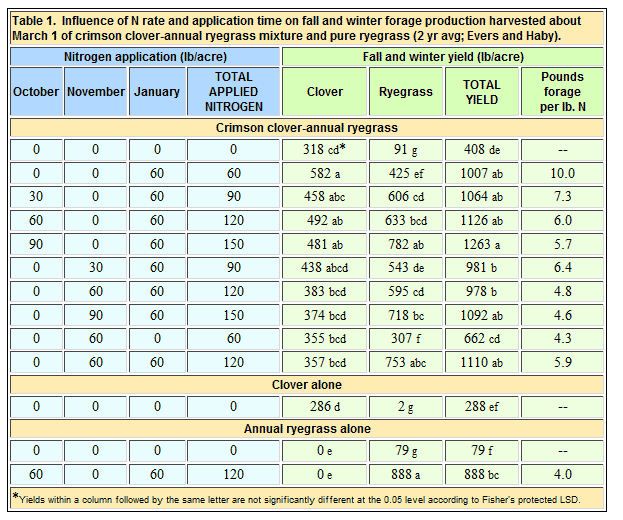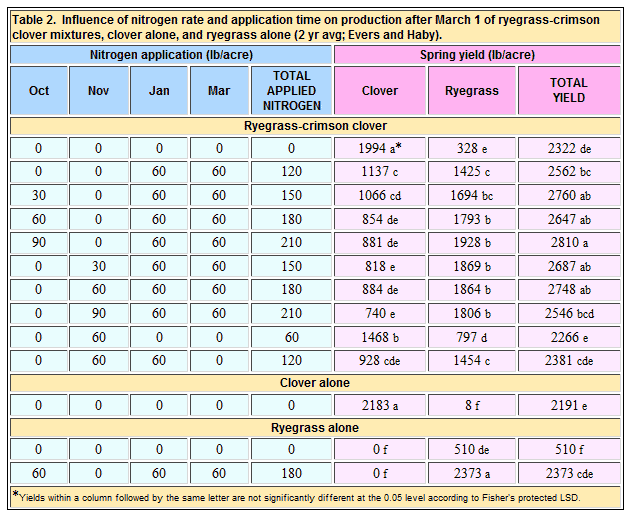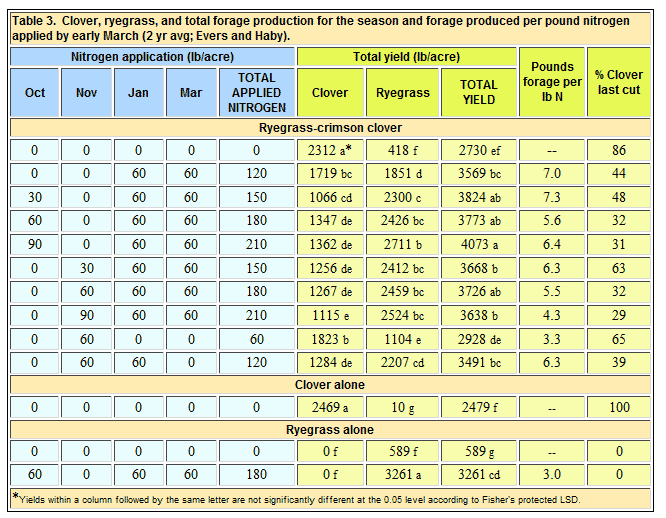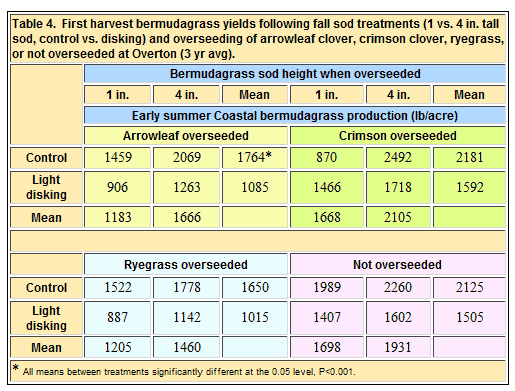Managing Pure Legume Stands
Planting forage legumes in pure stands is usually limited to seed production or to maximize legume forage production and N2-fixation as a green manure or winter cover crop. A soil sample should be analyzed to determine nutrient deficiencies, nutrient rate of application, and if lime is needed to raise the soil pH to a minimum of 6. Not more than 25 to 30 lb N fertilizer should be applied to a pure legume stand since it will reduce N2-fixation and increase weed competition.
The main management problem with a pure legume stand is usually weeds. Preplant herbicides cleared for clovers are Balan and Eptam which must be incorporated into the soil and therefore can only be used in prepared seedbed situations. Both are phytotoxic to annual grasses and cannot be used for clover-grass mixtures. The only postemergence herbicides cleared for use on forage legumes, other than alfalfa, are 2,4-DB and Kerb. Legumes should have 2 to 4 trifoliate leaves and broadleaf weeds must be less than 3 in. tall to use 2,4-DB. Even then, 2,4-DB may cause some temporary stunting of clover seedlings. Kerb contols some broadleaf weeds and some annual grasses including annual ryegrass and small grains. Therefore it should only be used on pure legume stands. All herbicides cleared for clovers can be used on alfalfa in addition to duiron, metribuzin, poast, pursuit, sinbar, trifluralin, and velpar. More herbicides are available for alfalfa because the large alfalfa acreage and the regular use of herbicides to establish alfalfa is a large and consistent herbicide market. Grazing can also be used to keep weeds under control. Livestock will eat most weeds when they are young. Having good thick legume stands from planting the recommended seeding rate on a clean, firm seedbed will help reduce weed problems.
Prepared seedbed: Establishing a pure legume stand in a prepared seedbed is most often used in a rotation with row crops or in organic farming systems. In both instances the legume is providing winter weed control and nitrogen to the farming system. The legume crop is usually disked down 4 to 6 weeks before planting the following crop. In some instances the legume is killed with a herbicide and the following crop is sodseeded into the dead legume crop. In a prepared seedbed scenario, required nutrients should be applied before final land preparation so they can be disked into the soil.
Overseeding: A shallow (1-2 in.) disking of the warm-season grass sod will improve stands of the overseeded legume because of reduced grass competition and the loose soil provides better seed placement. Any limiting plant nutrients should generally be applied after low temperatures limit warm-season grass growth. Growing seasons of the cool-season annual legume and warm-season perennial grass usually overlap during April and May depending on maturity of legume species. Beginning in early spring it is important to keep the legume grazed to a 3 to 5-in. height so sunlight can penetrate the legume canopy to stimulate growth of the warm-season grass. If the legume is not kept short in spring, early summer production of the perennial grass can be severely reduced. Poor soil moisture in late spring will also delay grass recovery. With crimson clover, some producers apply about 60 lb of nitrogen/acre as the clover begins to flower to stimulate grass growth. A mixture of clover and grass is harvested for hay. No additional nitrogen is applied for a second hay cutting because nitrogen should be available from the decaying legume roots and stubble.
Managing Legume-Grass Mixtures
Management of a cool-season legume-grass mixture is generally the same for a prepared seedbed and overseeding a warm-season grass. A prepared seedbed does allow for earlier planting and usually earlier forage production. There are several benefits to planting mixtures of cool-season legumes and annual grasses. The most important is an extended grazing period since cool-season legumes usually do not provide sufficient forage for grazing until late February or early March. Annual ryegrass and small grains can provide some forage in late autumn and winter depending on location. A legume-grass mixture also reduces the potential for bloat. A third benefit is that annual ryegrass seed can act as a carrier for small legume seed if the planter is not equipped with a special seed box for small seed.
Management of a legume-grass mixture requires an understanding of how legumes grow. The objective is to try to maintain a balance of legume and grass during the growing season. A general consensus is that a minimum of about 35% legume is necessary for the legume to make a significant contribution of forage and nitrogen. A well nodulated legume can obtain nitrogen from the air or soil. Grass is completely dependent on soil nitrogen. In a legume-grass mixture the legume will have the competitive edge as long as soil nitrogen is limiting. Applying nitrogen fertilizer to a legume-grass mixture will stimulate growth of the grass. If sufficient nitrogen is applied, the grass will shade out the legume to the point where it will be substantially reduced or eliminated from the mixture.
Although legumes are planted in autumn, from 75 to 90% of the total forage production occurs in the spring depending on species and location. The challenge to the producer is to provide enough nitrogen for the grass to produce forage in the fall and winter while maintaining the legume stand for spring forage production. No nitrogen should be applied after March 1 if the legume accounts for about half of the available forage at that time since spring is the major legume-growing period. The producer has two management tools to control the percent legume in a mixture; rate and time of nitrogen fertilizer application and height of the pasture sward.
A study to determine the influence of timing and number of nitrogen fertilizer applications to a crimson clover-annual ryegrass mixture overseeded on bermudagrass was conducted for two growing seasons at the Texas A&M AgriLife Research and Extension Center at Overton. Nitrogen rates of 30, 60, and 90 lb/acre were applied at planting or about four weeks later when the clover seedlings had reached the first true leaf stage. An additional 60 lb of nitrogen/acre was applied in January to most of the treatments. A pure stand of annual ryegrass with and without nitrogen fertilizer and a pure stand of crimson clover were also included. The study was harvested for the first time in early March.
As expected, clover yields were low during the fall and winter with dry matter yields ranging from 286 to 582 lb/acre (Table 1). The lowest clover yields were in the pure clover stand and the mixture with no nitrogen. The highest clover yields were where nitrogen was applied only in January or at planting and in January. This implies that crimson clover did respond to nitrogen fertilizer, especially to that applied in January. The optimum temperature reported for N2-fixation in white clover was from 550 to 800F with no N2-fixation occurring when soil temperature was below 480F. Therefore at soil temperatures below 480F, soil nitrogen would be the only nitrogen source for clovers. Ryegrass was more responsive to nitrogen. The importance of nitrogen for fall and winter grass production was demonstrated by yields of less than 100 lb of ryegrass/acre when no nitrogen was applied to a pure ryegrass stand or mixture. The trend was for ryegrass production to increase as the total amount of nitrogen applied increased. Ryegrass yields were also low in treatments that received no nitrogen in January.
The combined yield of clover and ryegrass by early March was lowest for the no nitrogen treatment which was similar to the pure clover stand (Table 1). But it was three to five times greater than ryegrass alone with no nitrogen. Applying nitrogen in January had the greatest impact on combined yields. Applying 60 lb nitrogen only in January produced yields equal to those where up to 150 lb of nitrogen was applied. Pounds of forage produced per pound of nitrogen fertilizer applied were calculated by subtracting the clover-ryegrass yield without nitrogen from the other treatments. The yield difference was divided by the pounds of nitrogen applied in each treatment. The greatest production per pound of nitrogen applied by early March was when only 60 lb nitrogen was applied in January.
 Clover production during the spring was the highest when planted in a pure stand or mixed with ryegrass without nitrogen fertilizer (Table 2). Spring clover yields tended to decrease as the amount of nitrogen fertilizer applied increased. Ryegrass yields were the highest with a pure stand of ryegrass with 180 lb N/acre and the lowest where no nitrogen was applied in January. Comparing the total spring yields, the clover-ryegrass with no nitrogen produced as much forage as the pure stand of ryegrass with 180 lb of nitrogen.
Clover production during the spring was the highest when planted in a pure stand or mixed with ryegrass without nitrogen fertilizer (Table 2). Spring clover yields tended to decrease as the amount of nitrogen fertilizer applied increased. Ryegrass yields were the highest with a pure stand of ryegrass with 180 lb N/acre and the lowest where no nitrogen was applied in January. Comparing the total spring yields, the clover-ryegrass with no nitrogen produced as much forage as the pure stand of ryegrass with 180 lb of nitrogen.
 Yields for the entire growing season are reported in Table 3. Other than the pure ryegrass stand with no nitrogen, clover-ryegrass with no nitrogen or only 60 lb nitrogen at the first true clover leaf stage were the least productive. The greatest clover-ryegrass yields occurred with 30 to 90 lb N at planting or first true clover leaf stage followed by 60 lb N in January and March. These treatments had higher yields than the pure ryegrass with 180 lb N. The most efficient use of nitrogen fertilizer was 7 lb forage produced per lb nitrogen applied when clover-ryegrass was fertilized with 60 lb N in January and March with or without 30 lb N at planting. This was twice the response of applying N to a pure stand of ryegrass. The percent clover at the last harvest shows the decrease in clover as the amount of N applied increased.
Yields for the entire growing season are reported in Table 3. Other than the pure ryegrass stand with no nitrogen, clover-ryegrass with no nitrogen or only 60 lb nitrogen at the first true clover leaf stage were the least productive. The greatest clover-ryegrass yields occurred with 30 to 90 lb N at planting or first true clover leaf stage followed by 60 lb N in January and March. These treatments had higher yields than the pure ryegrass with 180 lb N. The most efficient use of nitrogen fertilizer was 7 lb forage produced per lb nitrogen applied when clover-ryegrass was fertilized with 60 lb N in January and March with or without 30 lb N at planting. This was twice the response of applying N to a pure stand of ryegrass. The percent clover at the last harvest shows the decrease in clover as the amount of N applied increased.
Overseeded clover-ryegrass may not receive any N or up to two applications, depending on the amount of early forage production needed. Without N, sufficient forage for grazing is not available until late February or early March, depending on location. Most efficient use of N fertilizer was with 60 lb N in January and March. The most economical fertilization program is probably a single N application in December or January to enhance ryegrass production during the winter when there is very little clover growth. In this scenario, sufficient forage for grazing should be available in January or early February.
Pasture height in late fall and winter should not exceed 5 to 6 in. to avoid shading of the legume. In northeast Texas, grass production is limited by low temperatures in January and February. However, the tendency for producers is to accumulate 8 to 10 in. of growth before grazing is initiated to have sufficient forage during the winter. This would eliminate most legume plants from the mixture. If maximum forage production is the objective, an all grass pasture with high rates of nitrogen fertilizer would be the better option. The legume-grass mixture with limited nitrogen fertilizer will be less productive and have a lower carrying capacity but will have a lower cost per animal unit or pound of gain.
Summer Grass Recovery
Autumn management practices such as a light disking, grazing, or mowing the summer grass short enhances early forage production of overseeded winter forages. However, these same practices also slow down the spring recovery of the warm-seasonal perennial grass. A three-year study at the Texas AgriLife Research and Extension Center at Overton has shown that the autumn sod treatments hindered Coastal bermudagrass recovery even if not overseeded (Table 4). Disking reduced bermudagrass yields by an average of 600 to 700 lb/acre through mid to late June. Mowing the bermudagrass sod to a 1-in.vs 4-in. sod height reduced yields an average of 500 lb/acre when overseeded with clover, 250 lb/acre when overseeded with ryegrass or not overseeded. However, Coastal bermudagrass not overseeded was overgrown with winter weeds that hindered early bermudagrass growth.
Hay meadows that are managed for 3 to 6 cuttings a year should not be overseeded because of the spring competition to the warm-season grass eliminates a May hay cutting. If only two hay cuttings are normally required there should be no major problems with overseeding. Another option is to use pastures other than hay meadows for overseeded winter pasture.
| Next: Utilization | Back to Cool Season Legumes |



